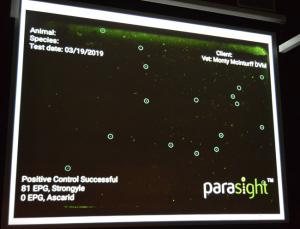By Nancy Brannon, Ph.D.
Kicking off “Fecal Week,” (March 19-26) Tennessee Equine Hospital (TEH) Memphis invited clients and friends to a free presentation on the importance of parasite control, March 19, 2019 at the new Hospitality Room at the Show Place Arena. The evening included a taco dinner from Moe’s, and two expert representatives from Zoetis: Dr. Amy Poulin and Lauren Berner. TEH offered a special deal on Fecal Egg Counts (50% off) and the purchase of a dewormer (10% off) through the end of March, Dr. McInturff announced at the meeting.
Dr. Amy Poulin, Zoetis Equine Technical Services Veterinarian and ACVS board-certified large animal veterinary surgeon, was the main speaker of the evening. Her topic: “Equine Parasites, Dewormers, and Fecal Egg Counts Made Easy!”
Poulin described the key equine parasites: (1) Large strongyles (bloodworms); (2) Small strongyles (cyathostomes); (3) Roundworms (ascarids); (4) Tapeworms; (5) Pinworms; (6) Bots; (7) Habronema, aka stomach worms (summer sores).
Poulin explained a simplified version of a complex cycle: horses get parasites through a cycle of inadvertently ingesting the L3 larvae while grazing; the L3 larvae molt (L4 and L5) and develop to adults in the horse’s stomach; the parasite’s eggs are passed back into the pasture in the horse’s feces; and the eggs hatch and larvae develop on the pasture (L1, L2, and L3). How we break this cycle of parasite infestation begins with performing a fecal egg count (FEC), developing an appropriate deworming plan, and performing a follow-up FEC to determine the effectiveness of the dewormer.
But for many decades this was not the protocol. For over 40 to 50 years, in the traditional protocol, veterinarians prescribed an every two months (6-times/year) schedule to deworm the horses, rotating the chemical dewormer so that, hopefully, one was never used repeatedly. This was supposed to prevent parasites developing resistance to a particular dewormer chemical. And, at least once a year, the veterinarian “tube wormed” a horse – inserting a tube through the nasal passages into the horse’s stomach to send a chemical dewormer directly to the horse’s stomach. Dr. McInturff remembered the many times he “tube wormed” horses in his younger veterinarian days.
One major accomplishment came out of this: over 40 years ago Large strongyles (bloodworms) were the parasite of greatest concern. Bloodworms can do enormous damage to the horse’s artery that supplies blood flow to the intestines, causing anemia, colic, and infection associated with fatal colic. Ivermectin was very effective against Large strongyles and now, Poulin said, these parasites are no longer of greatest concern.
Poulin said that today, Small strongyles (cyathostomins) are one of the parasites of greatest concern in adult horses. They very small, less than 1 inch, red worms occur in large numbers: 30,000 to 1,000,000+! They are difficult to control because they can “hibernate” in the wall of intestines (encysted) for months to years and few dewormer products get these encysted small strongyles; moxidectin is the main one. Poulin went over the clinical signs of small strongyle infestation.
Next, Poulin explained roundworms or ascarids, which are the parasite of primary concern in foals, weanlings, and young horses. She said, “They are large, cream-colored worms, about the thickness of a pencil, and live in the small intestine.” She described the impact of roundworms on foals and said that adult horses tend to develop an immunity to ascarids. So, foals need to be dewormed at different rates than adult horses.
Tapeworms may cause significant damage to the large intestine and cecum and can lead to colic. The horse becomes infected by swallowing the pasture mite, which ingests tapeworm eggs. Poulin showed a map of tapeworm prevalence in horses by U.S. state and region. In Tennessee, the prevalence is 84.3%; in Mississippi and Alabama, 82.7%; but in Arkansas and Missouri, only 30.5%.
Intense tail rubbing can be an indication of Pinworms infestation. Pinworms deposit their eggs under the horse’s tail and cause extreme itching. They can be passed from horse to horse if another horse rubs his tail at a place where an infected horse has rubbed his tail.
The fall brings those pesky botflies which lay their eggs on horses’ legs. If the horse licks an area with the botfly egg, the egg gets on the tongue, is ingested, and the botfly larvae over winter in the horse’s stomach. They are sometimes seen when horses are “scoped” for ulcers.
The Habronema, or stomach worm “is the bane of horses in Florida and the Gulf Coast region,” Poulin said. The horse gets a wound, flies bite and deposit their eggs in the wound, and it can become a festering, non-healing wound. Sometimes surgical debridement of the area is required. These are the worms that cause summer sores.
Using dewormers properly was a major theme of Poulin’s presentation. Periodically she had the audience guess the weight of a horse pictured on the screen. Most of the time the estimates were way off, illustrating that horse owners often under estimate their horse’s weight. Having an accurate weight measurement is important because dewormers are dosed according to the horse’s weight. If a dewormer is given in inadequate doses, or given too frequently, then parasites can develop resistance to the chemical. Most dewormers have product for a 1200-pound horse. But Poulin said that Zoetis now has two products for 1500-pound horses.
There are 4 main classes of deworming compounds (anthelmintics) used to control internal parasites in horses: benzimidazoles, pyrantels, macrocyclic lactones (ivermectin, moxidectin), and praziquantel. Different classes have different effectiveness against different types of parasites. Poulin said that Zoetis has NO plans to develop any new chemical dewormers. So it’s important to avoid parasite resistance by using dewormers properly.
Parasite resistance occurs when the same dewormer is used too frequently, when under-dosing because of under estimating the animal’s weight, and improper administration of the dewormer. And some farms have already developed resistant strains of parasites to some dewormers, Poulin said.
So, veterinary science has moved away from the traditional deworming schedule (discussed above) to an individualized parasite control regimen. It begins with a fecal egg count (FEC) to determine exactly what parasites the horse may have, in what intensity, and then develop an appropriate deworming plan. She recommended that all horses have at least two treatments per year, and doing the FECs in the spring and fall when horses are having their wellness exams and vaccinations.
Poulin explained how FECs are obtained and showed examples of slides and how types of parasites are counted. Based on the count, horses are classified as (1) low shedders (<200 eggs/gram); (2) moderate shedders (200-500 eggs/gram); (3) high shedders (>500 eggs/gram). She said that “20% of the horses on the property have 80% of the parasite burden (are high shedders). The other 80% are low shedders.”
Poulin recommended for further edification the American Association of Equine Practitioners (AAEP) Parasite Control Guidelines. Find them here:
https://aaep.org/sites/default/files/Guidelines/AAEPParasiteControlGuidelines_0.pdf
Poulin showed the Parasiticides Comparison Chart, which are listed by chemical class and can be found here:
https://www.zoetisus.com/products/horses/quest-horse-dewormer/pdf/zoetis-equine-parasiticides-comparison-chart.pdf
Tennessee Equine Hospital is trying out a new type of imaging technology – over traditional microscope slides – called Parasight™. It identifies and counts strongyle and ascarid eggs, and then outputs a fluorescent image of the parasites and provides eggs per gram (“EPG”) for strongyle and ascarid eggs. The image can then be emailed to the horse owner. Find out more about this technology at: https://poop2proof.com/
Editor’s Notes: While you’re at the AAEP website, you will find several “owner guidelines” of interest, one for vaccinations.
Colorado State University has a recommended equine deworming schedule that is available here: http://csu-cvmbs.colostate.edu/Documents/recommended-equine-deworming-schedule.pdf
Kicking off “Fecal Week,” (March 19-26) Tennessee Equine Hospital (TEH) Memphis invited clients and friends to a free presentation on the importance of parasite control, March 19, 2019 at the new Hospitality Room at the Show Place Arena. The evening included a taco dinner from Moe’s, and two expert representatives from Zoetis: Dr. Amy Poulin and Lauren Berner. TEH offered a special deal on Fecal Egg Counts (50% off) and the purchase of a dewormer (10% off) through the end of March, Dr. McInturff announced at the meeting.
Dr. Amy Poulin, Zoetis Equine Technical Services Veterinarian and ACVS board-certified large animal veterinary surgeon, was the main speaker of the evening. Her topic: “Equine Parasites, Dewormers, and Fecal Egg Counts Made Easy!”
Poulin described the key equine parasites: (1) Large strongyles (bloodworms); (2) Small strongyles (cyathostomes); (3) Roundworms (ascarids); (4) Tapeworms; (5) Pinworms; (6) Bots; (7) Habronema, aka stomach worms (summer sores).
Poulin explained a simplified version of a complex cycle: horses get parasites through a cycle of inadvertently ingesting the L3 larvae while grazing; the L3 larvae molt (L4 and L5) and develop to adults in the horse’s stomach; the parasite’s eggs are passed back into the pasture in the horse’s feces; and the eggs hatch and larvae develop on the pasture (L1, L2, and L3). How we break this cycle of parasite infestation begins with performing a fecal egg count (FEC), developing an appropriate deworming plan, and performing a follow-up FEC to determine the effectiveness of the dewormer.
But for many decades this was not the protocol. For over 40 to 50 years, in the traditional protocol, veterinarians prescribed an every two months (6-times/year) schedule to deworm the horses, rotating the chemical dewormer so that, hopefully, one was never used repeatedly. This was supposed to prevent parasites developing resistance to a particular dewormer chemical. And, at least once a year, the veterinarian “tube wormed” a horse – inserting a tube through the nasal passages into the horse’s stomach to send a chemical dewormer directly to the horse’s stomach. Dr. McInturff remembered the many times he “tube wormed” horses in his younger veterinarian days.
One major accomplishment came out of this: over 40 years ago Large strongyles (bloodworms) were the parasite of greatest concern. Bloodworms can do enormous damage to the horse’s artery that supplies blood flow to the intestines, causing anemia, colic, and infection associated with fatal colic. Ivermectin was very effective against Large strongyles and now, Poulin said, these parasites are no longer of greatest concern.
Poulin said that today, Small strongyles (cyathostomins) are one of the parasites of greatest concern in adult horses. They very small, less than 1 inch, red worms occur in large numbers: 30,000 to 1,000,000+! They are difficult to control because they can “hibernate” in the wall of intestines (encysted) for months to years and few dewormer products get these encysted small strongyles; moxidectin is the main one. Poulin went over the clinical signs of small strongyle infestation.
Next, Poulin explained roundworms or ascarids, which are the parasite of primary concern in foals, weanlings, and young horses. She said, “They are large, cream-colored worms, about the thickness of a pencil, and live in the small intestine.” She described the impact of roundworms on foals and said that adult horses tend to develop an immunity to ascarids. So, foals need to be dewormed at different rates than adult horses.
Tapeworms may cause significant damage to the large intestine and cecum and can lead to colic. The horse becomes infected by swallowing the pasture mite, which ingests tapeworm eggs. Poulin showed a map of tapeworm prevalence in horses by U.S. state and region. In Tennessee, the prevalence is 84.3%; in Mississippi and Alabama, 82.7%; but in Arkansas and Missouri, only 30.5%.
Intense tail rubbing can be an indication of Pinworms infestation. Pinworms deposit their eggs under the horse’s tail and cause extreme itching. They can be passed from horse to horse if another horse rubs his tail at a place where an infected horse has rubbed his tail.
The fall brings those pesky botflies which lay their eggs on horses’ legs. If the horse licks an area with the botfly egg, the egg gets on the tongue, is ingested, and the botfly larvae over winter in the horse’s stomach. They are sometimes seen when horses are “scoped” for ulcers.
The Habronema, or stomach worm “is the bane of horses in Florida and the Gulf Coast region,” Poulin said. The horse gets a wound, flies bite and deposit their eggs in the wound, and it can become a festering, non-healing wound. Sometimes surgical debridement of the area is required. These are the worms that cause summer sores.
Using dewormers properly was a major theme of Poulin’s presentation. Periodically she had the audience guess the weight of a horse pictured on the screen. Most of the time the estimates were way off, illustrating that horse owners often under estimate their horse’s weight. Having an accurate weight measurement is important because dewormers are dosed according to the horse’s weight. If a dewormer is given in inadequate doses, or given too frequently, then parasites can develop resistance to the chemical. Most dewormers have product for a 1200-pound horse. But Poulin said that Zoetis now has two products for 1500-pound horses.
There are 4 main classes of deworming compounds (anthelmintics) used to control internal parasites in horses: benzimidazoles, pyrantels, macrocyclic lactones (ivermectin, moxidectin), and praziquantel. Different classes have different effectiveness against different types of parasites. Poulin said that Zoetis has NO plans to develop any new chemical dewormers. So it’s important to avoid parasite resistance by using dewormers properly.
Parasite resistance occurs when the same dewormer is used too frequently, when under-dosing because of under estimating the animal’s weight, and improper administration of the dewormer. And some farms have already developed resistant strains of parasites to some dewormers, Poulin said.
So, veterinary science has moved away from the traditional deworming schedule (discussed above) to an individualized parasite control regimen. It begins with a fecal egg count (FEC) to determine exactly what parasites the horse may have, in what intensity, and then develop an appropriate deworming plan. She recommended that all horses have at least two treatments per year, and doing the FECs in the spring and fall when horses are having their wellness exams and vaccinations.
Poulin explained how FECs are obtained and showed examples of slides and how types of parasites are counted. Based on the count, horses are classified as (1) low shedders (<200 eggs/gram); (2) moderate shedders (200-500 eggs/gram); (3) high shedders (>500 eggs/gram). She said that “20% of the horses on the property have 80% of the parasite burden (are high shedders). The other 80% are low shedders.”
Poulin recommended for further edification the American Association of Equine Practitioners (AAEP) Parasite Control Guidelines. Find them here:
https://aaep.org/sites/default/files/Guidelines/AAEPParasiteControlGuidelines_0.pdf
Poulin showed the Parasiticides Comparison Chart, which are listed by chemical class and can be found here:
https://www.zoetisus.com/products/horses/quest-horse-dewormer/pdf/zoetis-equine-parasiticides-comparison-chart.pdf
Tennessee Equine Hospital is trying out a new type of imaging technology – over traditional microscope slides – called Parasight™. It identifies and counts strongyle and ascarid eggs, and then outputs a fluorescent image of the parasites and provides eggs per gram (“EPG”) for strongyle and ascarid eggs. The image can then be emailed to the horse owner. Find out more about this technology at: https://poop2proof.com/
Editor’s Notes: While you’re at the AAEP website, you will find several “owner guidelines” of interest, one for vaccinations.
Colorado State University has a recommended equine deworming schedule that is available here: http://csu-cvmbs.colostate.edu/Documents/recommended-equine-deworming-schedule.pdf











